Shopping Cart
Remove All Your shopping cart is currently empty
Your shopping cart is currently empty
Anti-JUN Polyclonal Antibody is a Rabbit antibody targeting JUN. Anti-JUN Polyclonal Antibody can be used in FCM,IF,IHC-Fr,IHC-P,WB.
| Pack Size | Price | USA Warehouse | Global Warehouse | Quantity |
|---|---|---|---|---|
| 50 μL | $220 | 7-10 days | 7-10 days | |
| 100 μL | $374 | 7-10 days | 7-10 days | |
| 200 μL | $529 | 7-10 days | 7-10 days |
| Description | Anti-JUN Polyclonal Antibody is a Rabbit antibody targeting JUN. Anti-JUN Polyclonal Antibody can be used in FCM,IF,IHC-Fr,IHC-P,WB. |
| Synonyms | V-jun avian sarcoma virus 17 oncogene homolog, Transcription factor Jun, Transcription factor AP-1 subunit Jun, Proto-oncogene c-Jun, p39, JUN, Activator protein 1 (AP1) |
| Ig Type | IgG |
| Reactivity | Human,Mouse,Rat (predicted:Chicken,Dog,Pig,Cow,Sheep) |
| Verified Activity | 1. Sample: Liver (Rat) lysate at 30 μg; Brain (Rat) lysates at 30 μg; Primary: Anti-C-jun/AP-1 (TMAB-01011) at 1:200; Secondary: HRP conjugated Goat-Anti-Rabbit Igg (secondary antibody) at 1: 3000; Predicted band size: 36 kDa Observed band size: 36 kDa 2. Paraformaldehyde-fixed, paraffin embedded (Mouse brain); Antigen retrieval by boiling in sodium citrate buffer (pH6.0) for 15 min; Block endogenous peroxidase by 3% hydrogen peroxide for 20 min; Blocking buffer (normal goat serum) at 37°C for 30 min; Antibody incubation with (C-jun) Polyclonal Antibody, Unconjugated (TMAB-01011) at 1:500 overnight at 4°C, followed by a conjugated secondary for 20 min and DAB staining. 3. Paraformaldehyde-fixed, paraffin embedded (Rat testis); Antigen retrieval by boiling in sodium citrate buffer (pH6.0) for 15 min; Block endogenous peroxidase by 3% hydrogen peroxide for 20 min; Blocking buffer (normal goat serum) at 37°C for 30 min; Antibody incubation with (C-jun) Polyclonal Antibody, Unconjugated (TMAB-01011) at 1:400 overnight at 4°C, followed by a conjugated secondary for 20 min and DAB staining. 4. Blank control (blue line): HepG2 (blue). Primary Antibody (green line): Rabbit Anti-C-jun antibody Dilution: 1 μg/10^6 cells; Isotype Control Antibody (orange line): Rabbit IgG. Secondary Antibody (white blue line): Goat anti-rabbit IgG-PE Dilution: 1 μg/test. Protocol The cells were fixed with 70% methanol (Overnight at 4°C) and then permeabilized with 90% ice-cold methanol for 20 min at-20°C. Cells stained with Primary Antibody for 30 min at room temperature. The cells were then incubated in 1 X PBS/2% BSA/10% goat serum to block non-specific protein-protein interactions followed by the antibody for 15 min at room temperature. The secondary antibody used for 40 min at room temperature. 5. Paraformaldehyde-fixed, paraffin embedded (Mouse brain); Antigen retrieval by boiling in sodium citrate buffer (pH6.0) for 15 min; Block endogenous peroxidase by 3% hydrogen peroxide for 20 min; Blocking buffer (normal goat serum) at 37°C for 30 min; Antibody incubation with (C-jun) Polyclonal Antibody, Unconjugated (TMAB-01011) at 1:400 overnight at 4°C, followed by a conjugated secondary antibody for 20 min and DAB staining. 6. Sample: Lane 1: Kidney (Mouse) Lysate at 40 μg Lane 2: Lung (Mouse) Lysate at 40 μg Lane 3: NIH/3T3 (Mouse) Cell Lysate at 30 μg Lane 4: Hela (Human) Cell Lysate at 30 μg Primary: Anti-C-jun (TMAB-01011) at 1/1000 dilution Secondary: IRDye800CW Goat Anti-Rabbit IgG at 1/20000 dilution Predicted band size: 43/36 kDa Observed band size: 45 kDa 7. Blank control: Hela. Primary Antibody (green line): Rabbit Anti-C-jun antibody (TMAB-01011) Dilution: 1 μg/10^6 cells; Isotype Control Antibody (orange line): Rabbit IgG. Secondary Antibody: Goat anti-rabbit IgG-AF647 Dilution: 1 μg/test. Protocol The cells were fixed with 4% PFA (10 min at room temperature) and then permeabilized with 90% ice-cold methanol for 20 min at-20°C. The cells were then incubated in 5% BSA to block non-specific protein-protein interactions for 30 min at room temperature. Cells stained with Primary Antibody for 30 min at room temperature. The secondary antibody used for 40 min at room temperature. 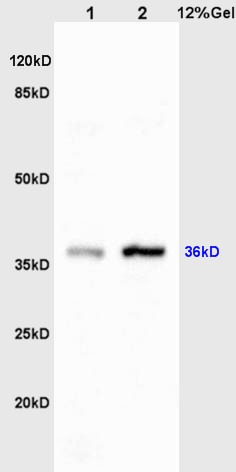 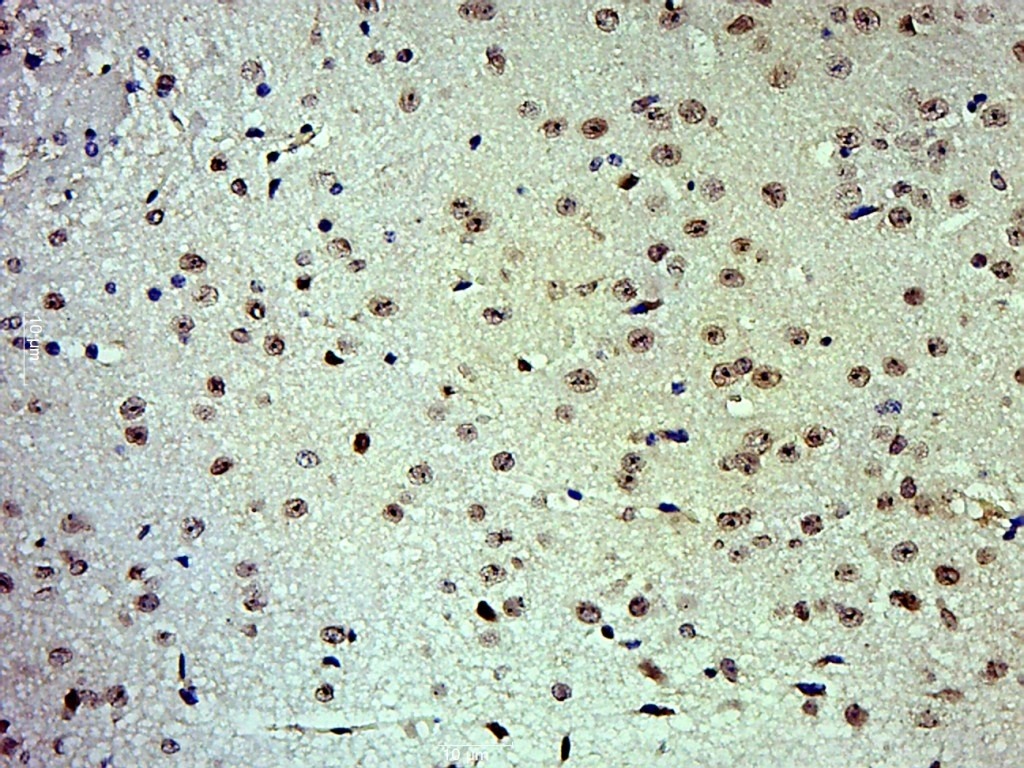 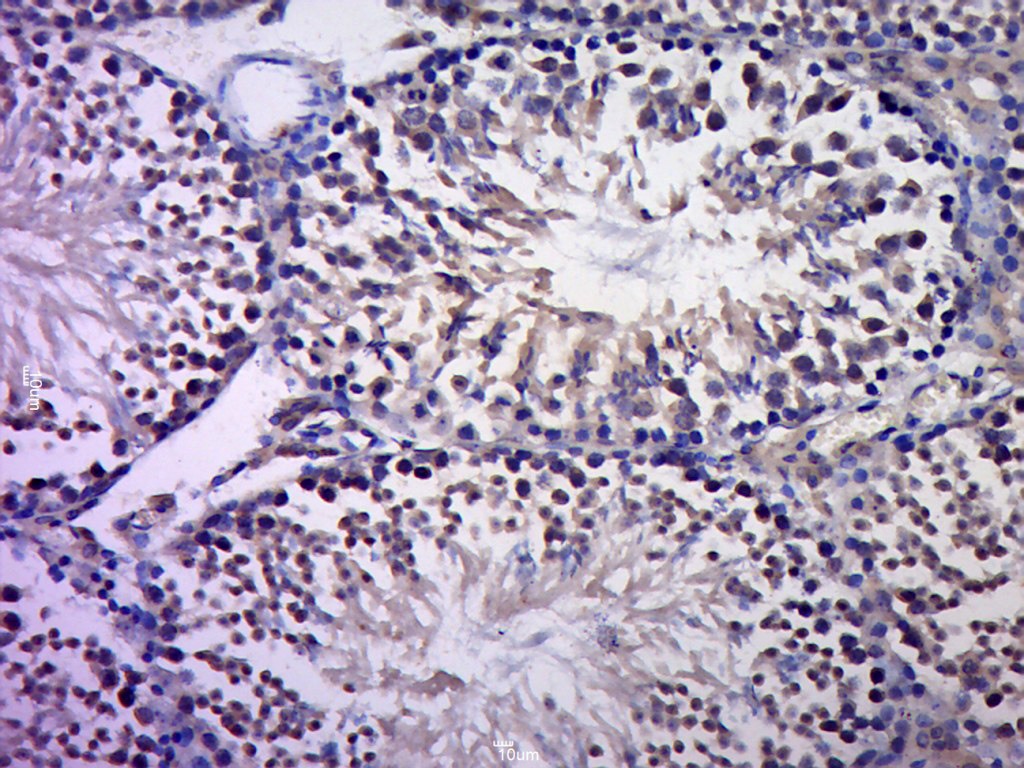 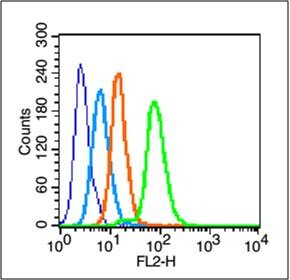 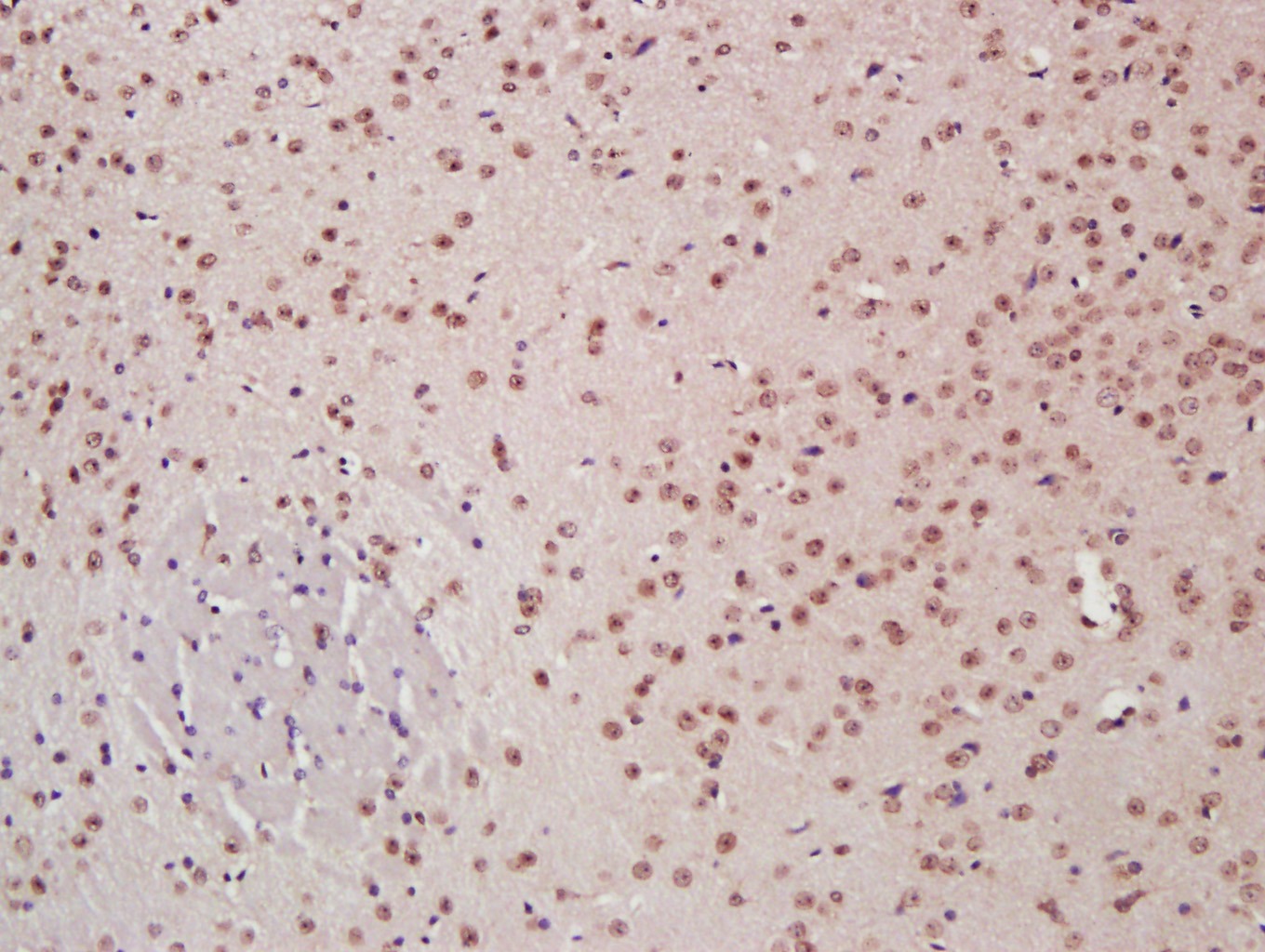 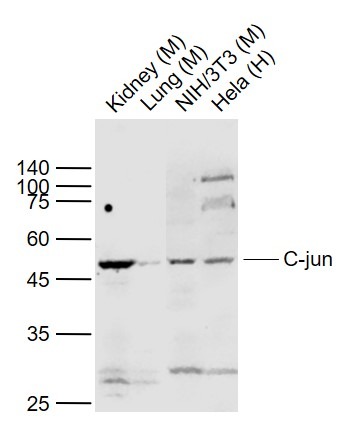 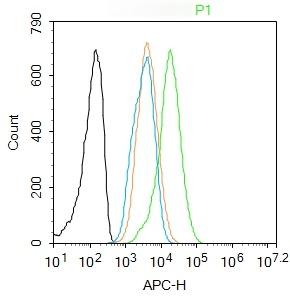 |
| Application | |
| Recommended Dose | WB: 1:500-2000; IHC-P: 1:100-500; IHC-Fr: 1:100-500; IF: 1:100-500; FCM: 1μg/Test |
| Antibody Type | Polyclonal |
| Host Species | Rabbit |
| Subcellular Localization | Nucleus. |
| Construction | Polyclonal Antibody |
| Purification | Protein A purified |
| Appearance | Liquid |
| Formulation | 0.01M TBS (pH7.4) with 1% BSA, 0.02% Proclin300 and 50% Glycerol. |
| Concentration | 1 mg/mL |
| Research Background | C-jun (Oncoprotein C-jun) is a component of the transcription factor AP-1 that binds and activates transcription at TRE/AP-1 elements and appears to be a major downstream target of the SAPK/JNK signaling pathway. The transcriptional activity of c-Jun is regulated by phosphorylation at Ser63 and Ser73. Extracellular signals including growth factors, transforming oncoproteins and UV irradiation stimulate phosphorylation of c-Jun at Ser63/73 and activate c-Jun dependent transcription. Mutation of Ser63/73 renders c-Jun nonresponsive to mitogenic and stress induced signaling pathways. The MAP kinase homologue, SAPK/JNK, binds to the N-terminal region of c-Jun and phosphorylates c-Jun at Ser63/73. In addition, the activity of SAPK/JNK is stimulated by the same signals that activate c-Jun. |
| Immunogen | KLH conjugated synthetic peptide: human Transcription factor AP-1 |
| Antigen Species | Human |
| Gene Name | JUN |
| Gene ID | |
| Protein Name | Transcription factor AP-1 |
| Uniprot ID | |
| Biology Area | Transcription factors,SMADs,Leucine Zipper,Transcription Factors,TLR Signaling,Phosphoprotein ELISA kits,SMADs |
| Function | Transcription factor that recognizes and binds to the enhancer heptamer motif 5'-TGA[CG]TCA-3'. Promotes activity of NR5A1 when phosphorylated by HIPK3 leading to increased steroidogenic gene expression upon cAMP signaling pathway stimulation. |
| Molecular Weight | Theoretical: 36 kDa. Actual: 43/36 kDa. |
| Stability & Storage | Store at -20°C or -80°C for 12 months. Avoid repeated freeze-thaw cycles. |
| Transport | Shipping with blue ice. |
| Size | Quantity | Unit Price | Amount | Operation |
|---|

Copyright © 2015-2025 TargetMol Chemicals Inc. All Rights Reserved.